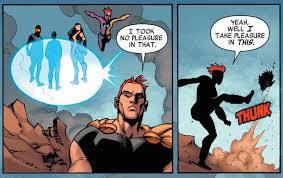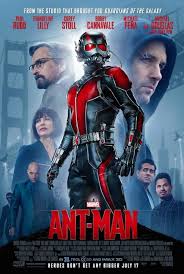As I read it I thought to myself, "This is freakin' HUGE! This is going to send ripples across the Marvel Universe the likes of which haven't been see in quite some time!"
That was a week ago. A quiet, frantic-due-to-the-holidays week. A week of...nothing.
Where were the headlines? Where was the interview with the writers? Where was the huge funeral and ceremony befitting the ruler of Atlantis?
There weren't any. Not even a 21 "Imperius Rex" salute.
But for those who haven't read it, and I've just spoiled it entirely, let's take a step back and see what happened in that fateful Squadron Supreme.
Out of the untold billions who died in the whole "Secret Wars" phenomena, the Squadron Supreme lives, as does Namor, and they are bent on making him pay. Let's review the players, shall we?
Kyle Richmond, Nighthawk of the late great Earth-31916
Dr. Spectrum, of the late Earth-4290001
Marcus Hilton, Hyperion, of the late Earth-13034
Jeff Walters, Blur, of the late Earth-148611
Zara Shelton, Power Princess, of the late Earth-712
and
Namor, of the Earth that seemed to start it all.
The story begins as the Squadron Supreme renders judgement and passes sentence on Namor. To quote Hyperion, "We all agree that Namor should pay for what he did--to you...and to this planet all the prior times he attached it. AND for the threat he continues to pose." In other words, Namor is to die.
Battle ensues with Namor questioning why he, and his city, are being attacked. He thinks aloud, "Now I recall talk--of how you'd taken up with other OUTCASTS from MISPLACED realities. I must say, Hyperion...your actions lack NUANCE from this association."
Then, the punch heard 'round the world.
Namor lands a blow on Hyperion that sends him clean out of the picture and into the position of executioner.
While the members of the Squadron Supreme keep Namor busy, Hyperion uproots the entire city of Atlantis...Namor's world. Being a gentleman, Hyperion shakes all of the citizenry into the ocean before smashing it into bite size bits of Atlantis.
Namor, enraged, attacks Hyperion and...this is where it happens. The moment all Namor-haters have looked forward to for ages! A graphic moment. A universe changing moment.
The moment where Hyperion decapitates Namor, the Sub-Mariner.
And the artists spare us none of the graphic imagery.
And we find some took pleasure in it while others did not.
But the Squadron Supreme offers no apologies
So, one has to ask, why the lack of press? He is certainly known the world over. A brief history shows that Namor (actual name: Namor McKenzie) debuted in 1939, created by Bill Everett for Funnies, Inc.
In Namor's first comic he is, surprise surprise, an enemy of the US. His first cover was Marvel Mystery Comics #4.
He was famous. Here's a synopsis straight from Wikipedia:
Namor was listed as the 88th greatest comic book character by Wizard magazine. IGN ranked Namor as the 77th greatest comic book hero of all time opining that "With the Atlanteans and X-Men both seeking their place in a dangerous world, Namor's role as leader is more vital than ever", and 14th in their list of "The Top 50 Avengers". In 2013, ComicsAlliance ranked Namor as #16 on their list of the "50 Sexiest Male Characters in Comics".
He was also infamous:
It leaves one to wonder if this was, perhaps, a dream sequence, or maybe Namor is joining the "dead only to be reborn" club of superheroes? Or, maybe, I was the only one that got the comic where Namor died. In the comic everyone else got, he lived.
WHY DIDN'T THIS CAUSE MORE RIPPLES IN THE COMIC BOOK OCEAN???
I mean, no matter what you thought of Homo Mermanus he deserved a better send-off than this. Marvel should have, and still can, make this a book deal. If they don't they're leaving money on the table.
Let me end with a more important question, however. Can we expect more things like this to come of the Squadron Supreme and other areas of the Marvel Universe? Are we now solving the "Should Superheroes Kill?" question? Should there be other villains, or heroes, put out to pasture? (OK, that's 3 questions). I, for one, would not be opposed.
As a matter of fact, I have a list of people I think should go the way of Namor and his head....
Follow the Comic Whisperer on Social Media!
Facebook: The Comic Whisperer
Twitter: @comic_whisperer
Pinterest: The Comic Whisperer
Webpage: www.comicwhisperer.com










































